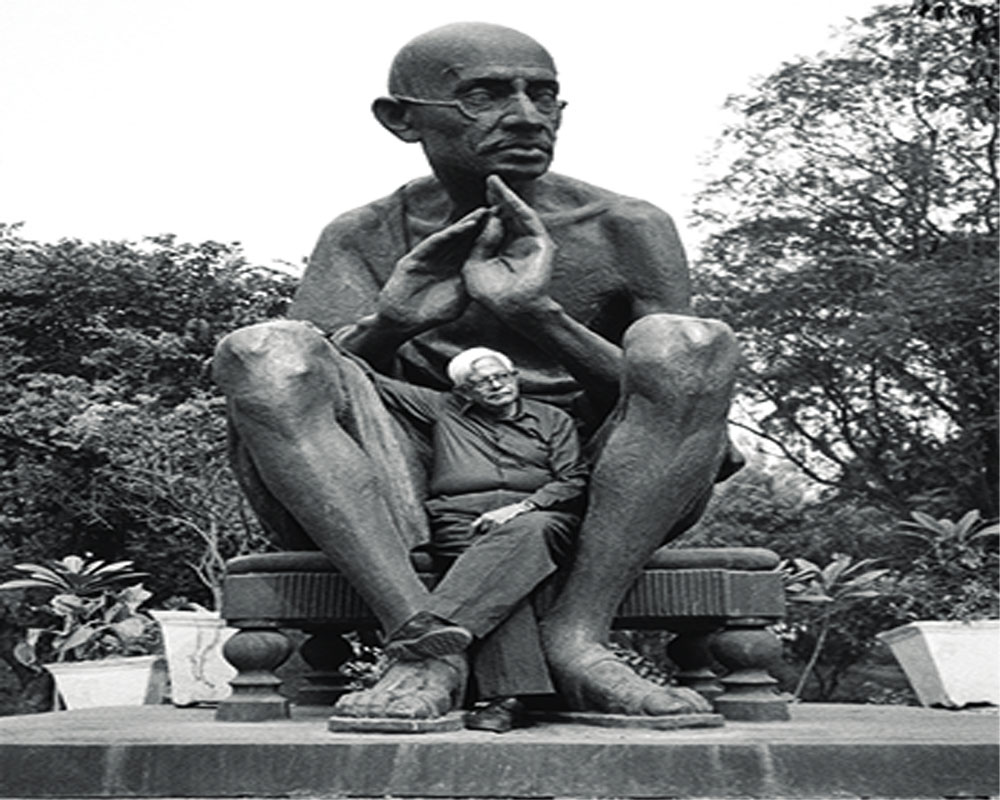Sumathi Ramaswamy traces the journey of the most analysed Indian of the 20th century through 131 paintings, sculptures, installations and multimedia works by various artists. Uma Nair pans her latest book — Gandhi in the Gallery: The Art of Disobedience
Traversing an odyssey of the prophet of disobedience who came to be known as a Mahatma, author and indologist Sumathi Ramaswamy’s book, Gandhi in the Gallery: The Art of Disobedience, published by Roli Books, is a well-researched magnum opus. Brilliant erudite and deeply driven by a rare quality of fine observation and critical prowess, Ramaswamy, a James B Duke distinguished professor of History at Duke University, has been scouring the nation, galleries, book periodicals and exhibitions to create this labour of love that looks at the Mahatma as a muse.
LN Tallur
On the cover is LN Tallur’s magnificent sculpture, Eraser Pro (2012, Nature Morte), which was unveiled at his historic show in New Jersey, Interference Fringe, which seemed more like a select retrospective of his series of definitive works. This sculpture of Mahatma Gandhi, which has been created as a dulcet fragmentation, incomplete in its insignia and dynamic in design, is a work that keeps one pondering. Tallur loves to keep his viewers guessing. He uses sculpture, wall pieces, interactive work and site-specific installations to expose the absurdities of everyday life and the anxieties that characterise contemporary society. His work incorporates handmade craftsmanship, found objects, organic and industrial material. They are symbolic of a developing India, at times, creating a correlation between its traditional and contemporary customs.
Nawal Kishore
Ramaswamy reveals the many ways in which Gandhi has served as a muse for painters, sculptors and multimedia artistes over the decades. The second example in the book, which contains 131 paintings, sculptures, installations and multimedia works on Gandhi belongs to the exhibition, Bapu@150 Years, was exhibited at the Lalit Kala Akademi, last year. This acrylic on canvas by Nawal Kishore is a flashback to January 10, 1908, when Gandhi was arrested for the first time, as he refused to carry an obligatory ID card in South Africa. Gandhi: An Untold Story retraces when he was arrested for the breach of the registration law and was later clapped into prison for the same. The following month he was released after an understanding was made with the government. A few days later, he was severely beaten up by a compatriot, who accused him of betraying the Indian cause. Kishore creates Mahatma with mask and wings. The mask was used as a metaphor for being silenced in the fight for recognition of exploitation and subjugation.
Gigi Scaria
Yet another powerful image in the books is that of Gigi Scaria. It is a morphed photograph of Devi Prasad Chowdhury’s perennial sculpture of the Dandi March in Delhi, which was conceptualised many years ago and executed by DG, NGMA, Adwaita Gadanayak. Scaria turns around the figures that follow Gandhi with the question — "Who deviated first?”
Scaria explained the analogy. "The 2010 work (digital print on archival paper) is based on the iconic Gyarah Murti sculpture in Delhi by Devi Prasad Roy Chowdhury that depicts the Dandi March led by Mahatma Gandhi in 1930. I was part of a group of artists who retraced that route in 2010, to commemorate 80 years of the iconic march. Gandhi had conceived this as a non-violent protest against the colonial salt laws. In my photograph, I have the 10 leaders walking in the opposite direction, who ask the viewers — When did we decide to deviate from the path? Gandhi has been relevant in different times in history but in our quest to reach higher goals, we have forgotten his ideals. The route we take to attain and assert freedom also matters. But that freedom comes with responsibility, and we need to be answerable for our actions. It is not just about the people who lead. Today, our nation is taking over us. To be willing to kill someone with the rationale that you are protecting Mother India is entirely wrong. This tragic understanding of the nation will only kill freedom, it can’t lead to it," he said.
Other artists
Ramaswamy creates some immeasurable and unending islands of thought and contemplation. From MF Hussain, Atul Dodiya, Upendra Maharathi to Ram Rahman’s famous image of Bhupen Khakar, sitting in the lap of a Gandhi statue in Delhi, the book is a collectible, rather, a souvenir, that every book and history lover must invest in.
One of Ramaswamy’s aims is to bring to light the labour of art that an artist puts in creating Mahatma. She wrote in her introduction, "Gandhi is unarguably the most analysed Indian of the 20th century, and my fellow historians and other social scientists have produced an enormous body of important scholarship on the man and his movement from which I have benefitted. But the deep suspicion of the image that is ingrained across the Social Sciences, and indeed, an unfounded conviction regarding its irrelevance, has meant that the labour of art in producing the phenomenon that we name the Mahatma has been largely ignored.”
























